|
|
A
Close-up View of the Wildflower (Centaurea jacea) |
|
|
A
Close-up View of the Wildflower (Centaurea jacea) |
Some
wildflowers are ubiquitous. Dandelions, thistles, Queen Anne’s
Lace, and many others can be found by simply looking around while out
of doors. Others are harder to find. Although several
varieties of Knapweed exist in Southern Ontario, their growth
requirements limit the number of locations where they can be found.
Brown Knapweed, the subject of this article, requires fairly cool,
moist locations. It originated in Europe and was brought to North
America by immigrants. Most Knapweeds are considered aggressive
and invasive plants, and this is particularly true for the two
commonest species, Spotted Knapweed and Brown Knapweed.
The plants are members of the ‘Aster family’, whose flower-heads are composite (an aggregation of small
individual flowers), containing both ray and disk flowers. The
genus name Centaurea
comes from Latin, and refers to Centaur Chiron who studied the
medicinal uses of plants. The species name jacea comes from
the Spanish name for Knapweed.
I have looked for, but never found Brown Knapweed in Toronto where I
live. Success was achieved while walking along the train tracks
which border a river in the town where I grew up (Hespeler). At
one point, the tracks pass through a limestone rock-cut. Not more
than two metres from the tracks, I found about 100 plants in bloom,
most growing up through the crushed stone stabilizing the wooden ties
that support the rails. I was astonished to find that all of the
plants were growing on one side of the tracks. Not one Knapweed
was to be found on the other side! (The condition existed again
this year, so more than just chance must be causing this
situation.) The image below shows the general location of the
plants, although the photograph was taken in early Fall, after the
plants had stopped blooming.

What sets the Knapweeds apart from other plants is the extremely
unusual series of modified leaves called bracts beneath the
flower-head. As can be seen in the image below of a bud, these
bracts are brown and look almost textile in nature. (The tips of
the bracts are light brown or beige in Brown Knapweed, and almost black
in Spotted Knapweed.)

Highly magnified, the intricate structure of a bract becomes
visible. Note the many ‘legs’ that seem to emanate from the
‘bug-like’ body.

In the bud shown earlier, all of the bracts are tightly layered to the
developing flower. For some reason the bud below seems to be
having a ‘bad hair day’!

As the flower-head begins to bloom, the topmost bracts are pushed aside
by the petals of ray flowers as they extend upwards.

A closer look at the base of the previous flower-head shows that each
bract is composed of a lower green striped section, and an upper brown
‘insect-like’ section.

Higher up, the brown parts are so tightly packed, that the lower green
portions are completely obscured.

The topmost bracts, just under the ray flowers, have a different top
that looks distinctly ‘comb-shaped’.

At first, the central area of disk flowers, (the white tubes) is small.

Later, all of the disk flowers are in full bloom. Note that they have
darkened to just slightly less pink than the outer ray flowers.

The unique bracts certainly set the Knapweed apart from other members
of the aster family.

The petals of the outer ray flowers of most composite flower-heads are
simple rectangular ribbons. In this species, they are much more
complex.

Under some conditions, the ray flower’s petals are curled almost into a
tube (first image). At other times, they flatten out as in the
second image.


Brown Knapweed has a ridged stem that is usually striped with narrow
purple bands. The upper leaves, as seen in the two images below,
are lance-shaped and are connected directly to the stem (without a
stalk). Leaves have a concave upper surface and become
progressively smaller the higher they are on the stem.


The first flowers to bloom in the composite head are the outer ray
ones. Only later do the central disk flowers open. The five
tiny petals of each disk flower are white in the images below. At
this stage, the stigma and style (female, pollen accepting
structures) are not visible. The dark purple tube extending from
each flower is formed from the five anthers
(male, pollen producing structures), which are fused together.

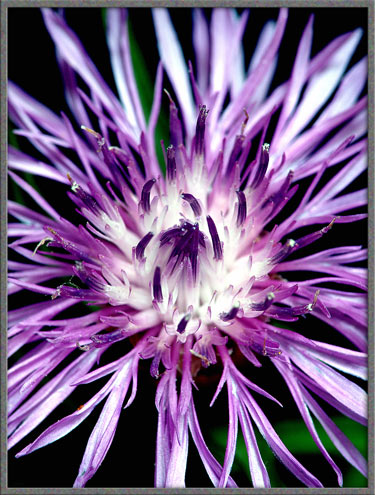
Using
higher magnification, it can be seen that many of the anther tubes have
a collection of pollen grains at their tip.
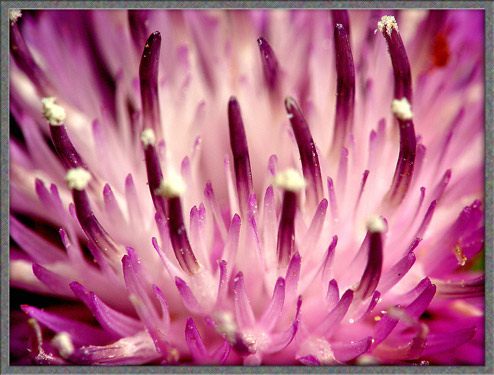
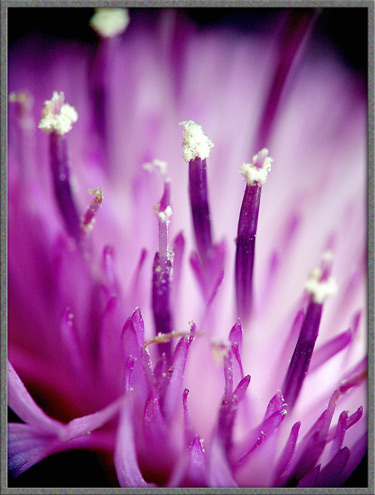
To produce the following image, I deliberately focused on the tips of
the disk flower petals, rather than on the anther tubes projecting out
of them.
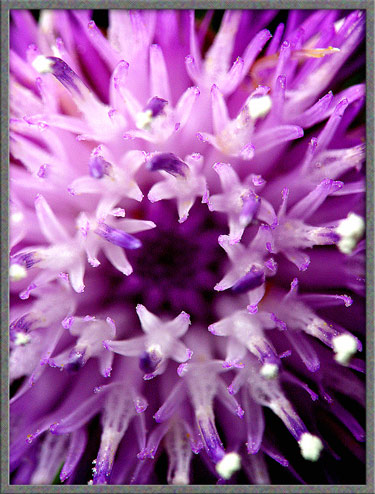
Growing up through the tube formed by the five fused anthers is the pistil, composed of the stigma and
style. Note that each stigma has two curved lobes.
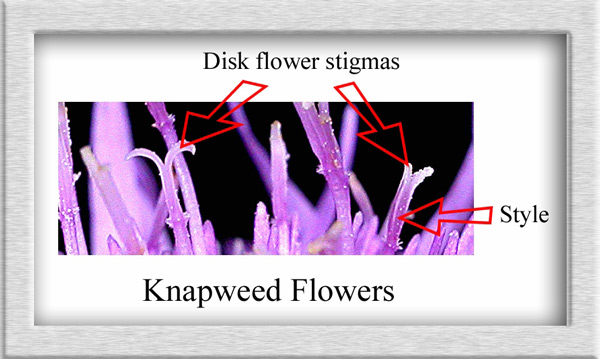
With a microscope it is possible to obtain even higher
magnifications. The first image shows two of the five anthers
forming the tube. Some pollen grains are visible at the tip of
the tube.
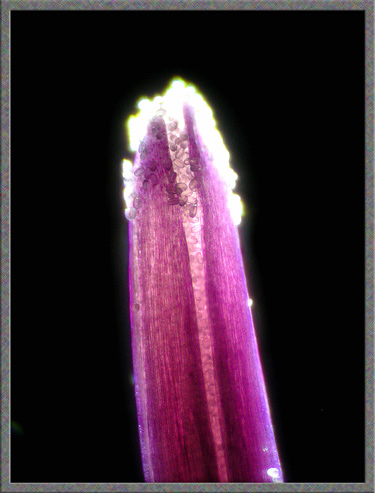
This second image, (using a slightly lower magnification), shows a
later time when the pistil has grown up out of the anther tube.
The two lobes of the stigma have not yet appeared.
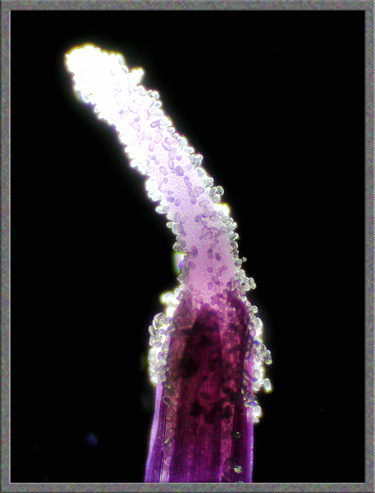
The pink structure below is the style which supports the stigma.
The stigma is the colourless structure. At the joining point
there are a number of hair-like projections which hold pollen grains.
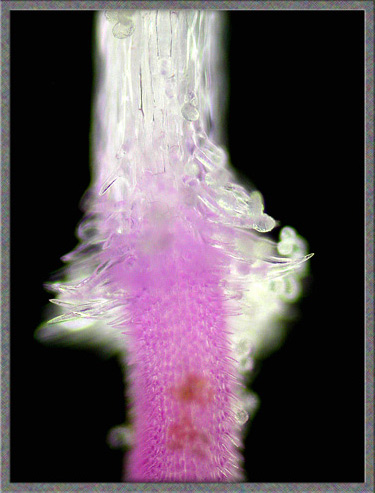
Pale yellow-white, egg-shaped pollen grains are visible stuck to the
surface of the style.
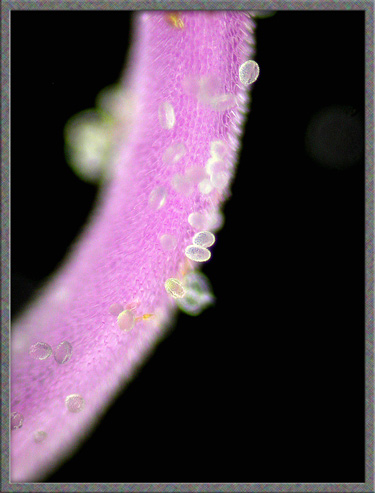
As the bi-lobed stigma matures, it becomes darker red in colour.
This photomicrograph shows pollen attached to the branching point.
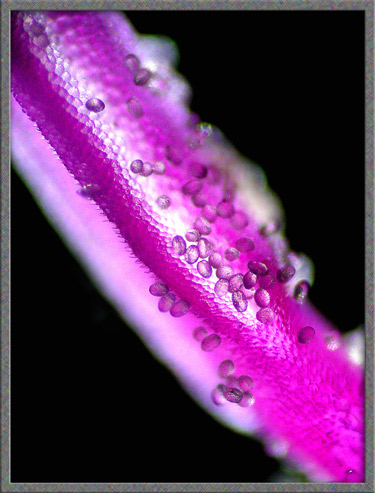
A higher magnification phase-contrast image of a pollen grain shows the
egg shape, and a line (groove?) that bisects the grain longitudinally.
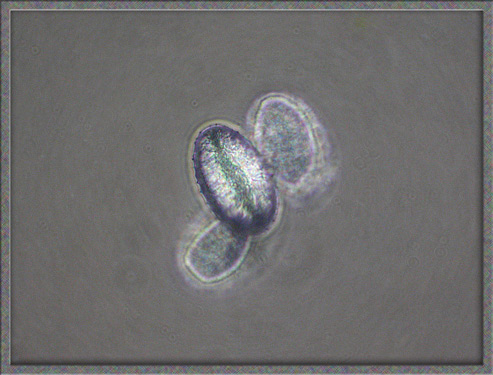
Like many wildflowers, Brown Knapweed has a variety of alternative
common names. Common Knapweed, Star-Thistle, Brown-Ray Knapweed,
Harshweed and Knapwort are just a few. My personal favorite is the
Welsh name for the species, Y
Bengaled Llwytgoch. The problem is that I don’t know how
to pronounce it!
Photographic Equipment
The photographs in the article were taken with an eight megapixel Sony
CyberShot DSC-F 828 equipped with achromatic close-up lenses (Nikon 5T,
6T, Sony VCL-M3358, and shorter focal length achromat) used singly or
in combination. The lenses screw into the 58 mm filter threads of the
camera lens. (These produce a magnification of from 0.5X to 10X
for a 4x6 inch image.) Still higher magnifications were obtained
by using a macro coupler (which has two male threads) to attach a reversed 50 mm focal length f 1.4
Olympus SLR lens to the F 828. (The magnification here is about
14X for a 4x6 inch image.) The photomicrographs were taken with a Leitz
SM-Pol microscope (using a dark ground condenser), and the Coolpix
4500.
References
The following references have been
found to be valuable in the identification of wildflowers, and they are
also a good source of information about them.
Published in the March
2006 edition of Micscape.
Please report any Web problems or
offer general comments to the Micscape
Editor.
Micscape is the on-line monthly magazine
of the Microscopy UK web
site at Microscopy-UK
© Onview.net Ltd, Microscopy-UK, and all contributors 1996 onwards. All rights reserved. Main site is at www.microscopy-uk.org.uk with full mirror at www.microscopy-uk.net .